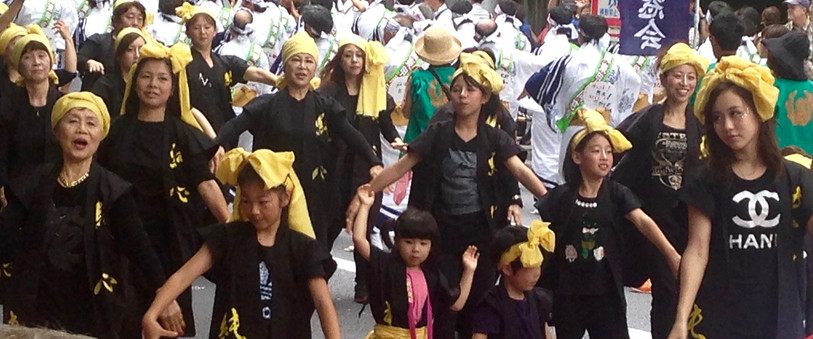Sunday, June 12, 2016
This past weekend was the two-day Shibuya-Kagoshima Ohara Festival with the highlight on Sunday: the parade of dancers. It is touted as one of the biggest festivals of this type…or something that made it a don’t-miss. I honestly couldn’t remember what its claim to fame was, but since I had added it to our calendar, I knew we had to make the trek.
Exiting the Shibuya station at the Hachiko Square side is the important first step, because as anyone who has been to Shibuya knows, the place is huge. We have exited on the wrong side many times, and it will instantly put you in a foul mood. Trust me.
Once we exited, we headed for the giant 109 sign that is across, and to the left, at the infamous Shibuya Crossing. For this event, they also had added a giant blow-up arch at the entrance to the parade area, so it really is hard to miss.
According to the program we picked up: the event is a traditional festival that Shibuya City and Kagoshima City have been jointly hosting for, I’m assuming, 19 years (since this is referred to as the 19th Festival). It consists of 65 groups representing the different areas around Japan all dancing in the parade to—according to the program—the ‘rhythm of the Ohara-bushi and the Shibuya ondo dance songs.’
The program also depicts the eleven steps to the dance if one wants to join in.
The parade is held on the Dogenzaka and Bunkarmura-dori streets that run along either side of the 109 building.
The parade started sometime after 12 with the Tokyo Fire and Disaster Management Agency Band marching past, playing a song, and carrying a banner showing some big object falling on a guy (nice). Their mascot was a big alien with a helmet for a head and weird antennae, who marched along in front of them waving, and was accompanied by a guy with strange mutton-chop sideburns who looked to be an escapee from the 1800s (not sure who he was).
Then Taiko drummers started drumming as the sixty-five groups gathered on the streets, preparing to dance, and posed for pictures. All the groups eventually lined up in two lines on both sides of the 109 building.
Once the singing began, one of the lines danced clockwise while the other one danced in a counter-clockwise direction. It was an ingenious way to keep the parade footprint small and to maximize the exposure for all sixty-five groups.
There were little kids, old people, and every age in between participating. They all danced the same dance moves (more or less) over and over again, accompanied by either a man, or a trio of women singing the traditional songs. Sometimes to speed it up, a recorded fast song was played and then everybody hightailed it quickly along.
All the colorful costumes were beautiful, and it was so enjoyable watching all the ages participating and sharing their passion. The music was interesting and inspiring, and the recorded dance song was snappy, too.
The parade went until about 3-ish with a thirty-minute break and a few little breaks along the way. I think there will be lots of tired dancers this morning.










No comments:
Post a Comment
Thank you for your comment.